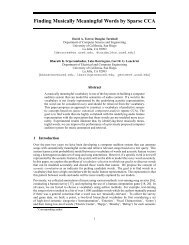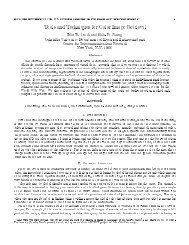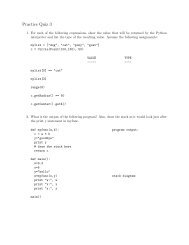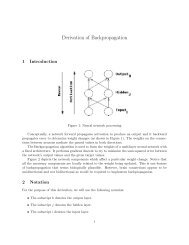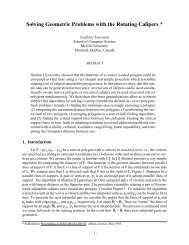Left-leaning Red-Black Trees - Princeton University
Left-leaning Red-Black Trees - Princeton University
Left-leaning Red-Black Trees - Princeton University
Create successful ePaper yourself
Turn your PDF publications into a flip-book with our unique Google optimized e-Paper software.
4reds110tree sizeAverage number of reds per path in random LLRB treesthough the total is relatively smooth. Close examination reveals that the average number of reds perpath increases slowly, then drops each time the root splits. One important challenge is to characterizethe root split events. The remarkablefigure at right shows that variability inthe time of root splits creates a significantchallenge in developing a detailedcharacterization of the average numberof red nodes per path. It is a modifiedTufte plot showing that this quantity oscillatesbetween periods of low and highvariance and increases very slowly, if atall. This behavior is the result of averagingthe sawtooth plots with differentroot split times like the ones at the bottomof the previous page. It is quite remarkable that the quantity of primary practical interest (theaverage path length) should be so stable (as shown in our first plot and in the sum of the blackand red path lengths in the plot at the bottom of the previous), but the underlying process shouldexhibit such wildly oscillatory behavior.AcknowledgementThe author wishes to thank Kevin Wayne for many productive discussions and for rekindling interestin this topic by encouraging work on the delete implementation.References1. G. M. Adelson-Velskii and E. M. Landis, An algorithm for the organization of information, Soviet Math.Doklady 3 (1962), 1259 –1263.2. A. Andersson, Balanced search trees made simple, Proceedings of the 3rd Workshop on Algorithmsand Data Structures (1993), 290 –306.3. R. Baeza-Yates, Fringe analysis revisited, ACM Computing Surveys 27 (1995), 109 –119.4. R. Bayer, Symmetric binary B-<strong>Trees</strong>: data structure and maintenance algorithms, Acta Informatica 1(1972), 290 –306.5. M. Brown, Some observations on 2-3 trees, Information Processing Letters 9 (1979), 57 –59.6. T. H. Cormen, C. E. Leiserson, R. L. Rivest and C. Stein, Introduction to Algorithms, MIT Press.7. L. Guibas and R. Sedgewick, A dichromatic framework for balanced trees, Proceedings of the 19th AnnualConference on Foundations of Computer Science, Ann Arbor, MI (1978). (Also in A Decade ofResearch — Xerox Palo Alto Research Center 1970–1980, ed. G. Laverdel and E. R. Barker).8. D. E. Knuth, The Art of Computer Programming, Vol. 3, Sorting and Searching, Addison–Wesley.9. R. Sedgewick, Algorithms in Java, Parts 1–4: Fundamentals, Data Structures, Sorting, and Searching,Addison–Wesley.10. R. Sedgewick and P. Flajolet, Introduction to the Analysis of Algorithms, Addison–Wesley, 1996.11. R. Seidel, personal communication.12. E. Tufte, Envisioning Information, Graphics Press, Chesire, CT, 1990.13. M. Weiss, Data Structures and Problem Solving using Java, Addison-Wesley, 2002.14. A. Yao, On random 2-3 trees, Acta Informatica 9 (1978), 159 –170.500



